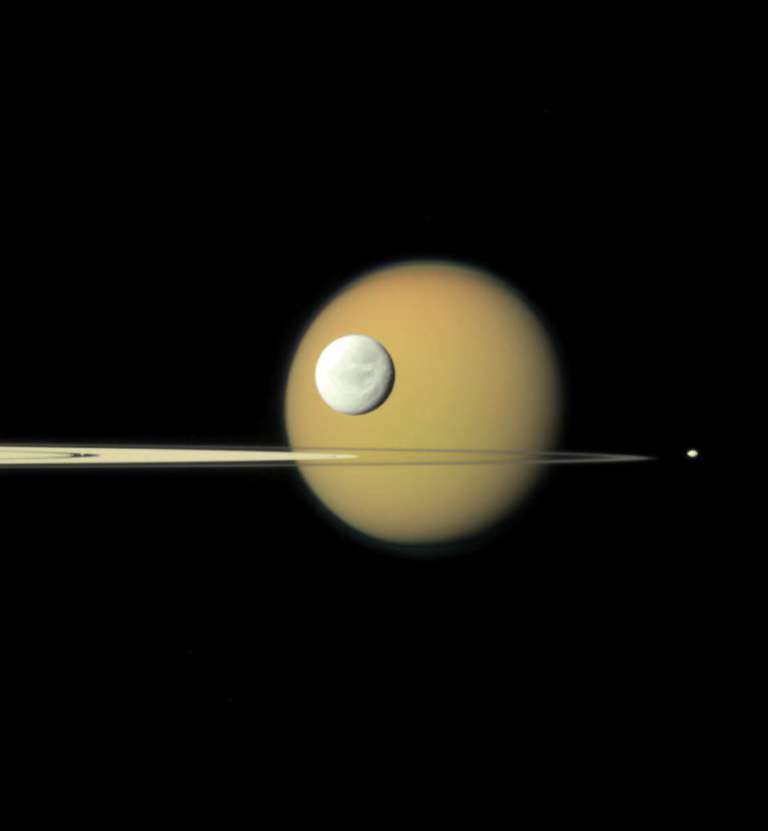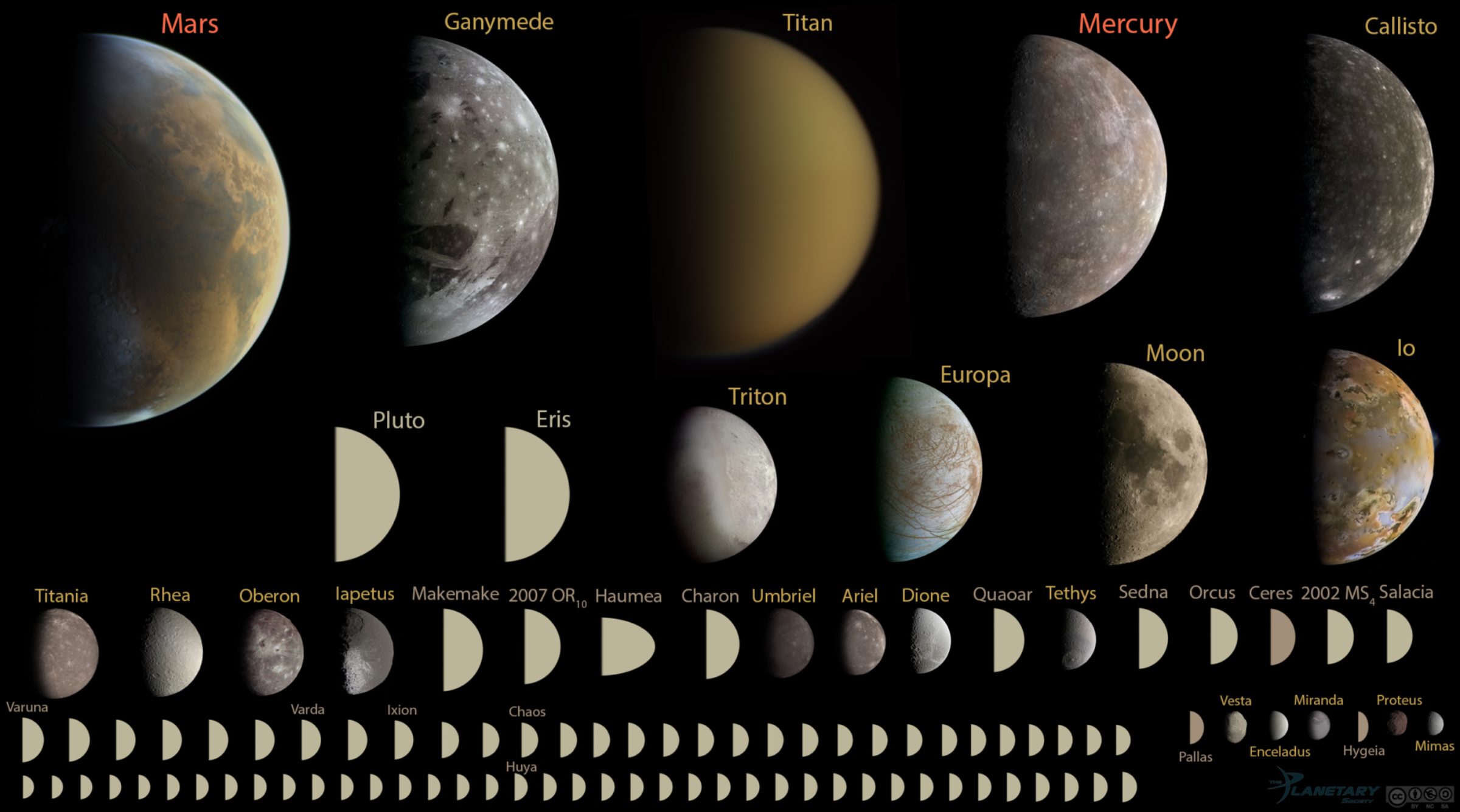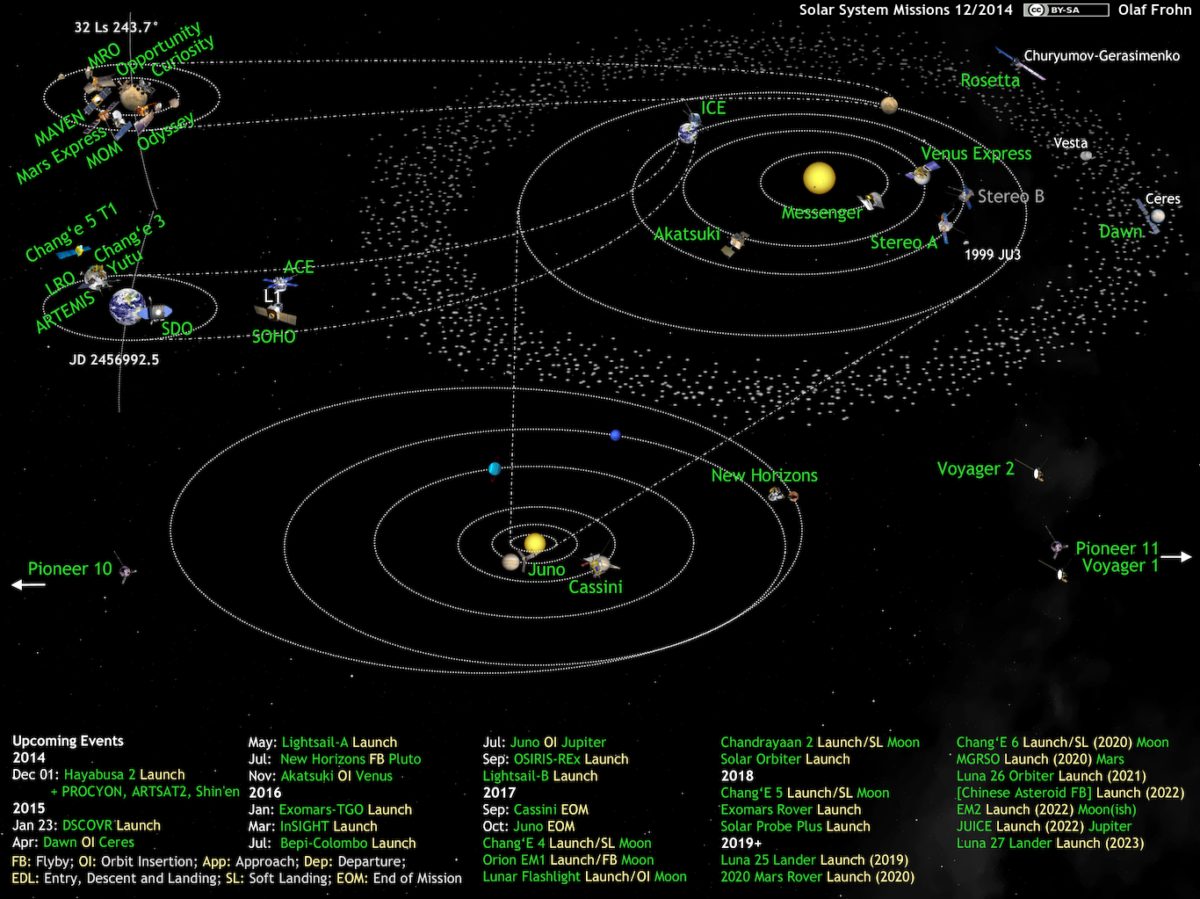Emily Lakdawalla • Dec 31, 2014
Planetary exploration in 2015: The Year of the Dwarf Planet
Looking ahead to what we can expect from Earth's exploration of the rest of the solar system in 2015, there's an obvious theme: Dwarf planets. Dawn enters orbit at Ceres in March, and will spend most of the rest of 2015 in a series of successively lower orbits until it finally achieves its lowest-altitude orbit in December. On July 14, New Horizons will flash past Pluto and Charon, studying two dwarf planets for the price of one. What else is going on in the solar system? As always, Olaf Frohn's diagram of active interplanetary probes helps us take it all in at a glance:
Not wanting to miss out on the dwarf planet fun, Cassini will return to dwarf-planet-sized icy moon studies this year, with repeated close flybys of Dione and Enceladus, and more distant observations of many of the other moons of Saturn. There is a detailed list of these encounters at the bottom of this post. Cassini moon flybys are made possible by a shift in Cassini's orbit that returns it to the plane of Saturn's rings. Orbiting in the ring plane means we'll get more awesome views like this one, captured during Cassini's previous equatorial orbit phase, in 2011:

With comet Churyumov-Gerasimenko headed toward perihelion in August, Rosetta will continue to be thrilling all year long, even if Philae never wakes up. But Philae could wake up, as early as March (but much more likely later in the year), and could possibly be actively sniffing comet atmosphere while it's at perihelion, which would be phenomenal. The first public data release from the Rosetta mission is scheduled to happen six months after the Philae landing, May 12, and should include data taken through the moment of landing -- at least, the first landing.
Moving on to Mars: 2015 begins with seven spacecraft active there as we begin the year. Of those seven, four are way past their prime. There's no particular reason to expect Odyssey, Opportunity, Mars Express, or Mars Reconnaissance Orbiter to fail in the coming year, but they won't last forever -- it seems like one of them has to cash it in this year. (I said the same thing last year, though, and they all came through 2014 just fine.) It will be a good year for surface operations: Mars reaches southern summer solstice on January 11, so it's the season of peak temperature and solar power time for the two rovers. Although Curiosity is not solar-powered, warm temperatures allow it to drive during more of the day, and leave more power available to run the hungry laboratory instruments.
Nearer home, Lunar Reconnaissance Orbiter will spend 2015 continuing its mission to map the Moon, and it will be joined in lunar orbit by the Chang'e 5 test vehicle, surveying for future Chang'e 5 landing sites. Chang'e 3 continues to operate from the lunar surface.
On a sadder note, the year 2015 will mark a hiatus in our exploration of the innermost solar system. Venus Express is in its final days and no longer communicating with Earth. MESSENGER will crash into Mercury in April (a month later than previously planned). With those two long-lived little spacecraft gone, we'll have no more planetary explorers doing science inside Earth's orbit. Japan's Akatsuki may possibly enter orbit at Venus in November, but it's a long shot, and even if it succeeds, it won't be in the orbit it was designed for. (I should mention here that a cryptic comment on the nasaspaceflight.com forum suggests that a November orbit insertion for Akatsuki may be off the table.) The data sets of Venus Express and MESSENGER will provide meat for scientists to chew on for several years, but it's going to be a decade until BepiColombo gets to Mercury, and there are currently no missions being built for launch to Venus. That's something we need to advocate for.
Speaking of advocacy, 2015 will be the Year of the Dwarf Planet, and as I've done before, I'm asking you -- yes, you -- to go forth and share your excitement about exploring these strange smaller worlds with everyone who passes through your Hill sphere. While the wider public generally knows the names of the planets, they are mostly not familiar with these smaller worlds -- except Pluto, about which the only thing most people know is that it isn't a planet anymore. (Ask people what they think Pluto is, and most won't be able to tell you; the most common response I get to this question is that, if it's not a planet, then it must be some kind of star.) That lack of public knowledge is hazardous to those of us who care about space exploration. Why should we spend so much public money exploring these less important worlds that no one has ever heard of?
So I'm charging you all to inspire your friends, family, coworkers, and all the other people who wander within your experience about the cool things in our solar system that are not planets. Teach your kids to rattle off the names of Saturn's major moons (those are Mimas, Enceladus, Tethys, Dione, Rhea, Titan, and Iapetus). Or some of the named members of the Kuiper belt (Eris, Pluto, Makemake, Haumea, Charon, Quaoar, Sedna, Orcus, Salacia, Varuna, Varda, Ixion, Chaos, Huya...). Share pictures of Enceladus' plumes or Titan's lakes or whatever it is we'll be discovering at Ceres and Pluto. Most of all, share your passion. And explain how much there is out there that we don't know -- so we have to keep exploring.
Here is a list of the dwarf planet / icy moon encounters expected for 2015. Put them on your calendar, and grab and share those pictures!
For Cassini, "targeted" flybys have low altitudes and major science campaigns, while "nontargeted" flybys are at longer distances and less stressful. Because the schedule is so packed with Cassini events, I've put Dawn and New Horizons events in bold text to make them stand out better.
- January 11: Cassini targeted flyby of Titan (970 km)
- February 10: Cassini nontargeted flyby of Rhea (46,900 km)
- February 12: Cassini targeted flyby of Titan (1200 km)
- March 6: Dawn Ceres orbit capture (61,000 km)
- March 16: Cassini targeted flyby of Titan (2280 km)
- April 11: Cassini nontargeted flyby of Tethys (52,900 km)
- April 23: Dawn reaches "RC3" orbit (13,500 km)
- May: Dawn reaches survey orbit (4,400 km)
- May: New Horizons images of Pluto/Charon are better than Hubble's
- May 7: Cassini targeted flyby of Titan (2720 km) followed by opportunistic observations of Polydeuces
- May 31: Cassini nontargeted flyby of Hyperion (34,300 km)
- June 16: Cassini targeted flyby of Dione (516 km) preceded by opportunistic observations of Polydeuces
- July: Dawn reaches high-altitude mapping orbit (1,470 km)
- July 5: Cassini nontargeted flyby of Telesto (14,200 km)
- July 7: Cassini targeted flyby of Titan (11,000 km)
- July 14: New Horizons Pluto flyby (13,700 km)
- July 27: Cassini nontargeted flyby of Dione (60,500 km)
- August 17: Cassini targeted flyby of Dione (479 km) and nontargeted flyby of Tethys (41,900 km)
- August 18: Cassini nontargeted flyby of Enceladus (53,200 km)
- September 8: Cassini nontargeted flyby of Dione (41,900 km)
- September 28: Cassini targeted flyby of Titan (1,040 km)
- September 30: Cassini nontargeted flybys of Dione (40,800 km) and Mimas (64,800 km)
- October 1: Cassini nontargeted flyby of Rhea (57,900 km)
- October 14: Cassini targeted flyby of Enceladus (1,845 km)
- October 28: Cassini targeted flyby of Enceladus (49 km)
- November 11: Cassini nontargeted flyby of Tethys (8,380 km)
- November 13: Cassini targeted flyby of Titan (11,900 km)
- November 23: Cassini nontargeted flyby of Tethys (17,400 km)
- December 6: Cassini nontargeted flyby of Epimetheus (2,630 km) followed by opportunistic observations of Prometheus and Atlas
- December: Dawn reaches low-altitude mapping orbit (375 km)
- December 19: Cassini targeted flyby of Enceladus (5,000 km)
- December 31: Cassini nontargeted flyby of Rhea (24,600 km)

The Time is Now.
As a Planetary Defender, you’re part of our mission to decrease the risk of Earth being hit by an asteroid or comet.
Donate Today

 Explore Worlds
Explore Worlds Find Life
Find Life Defend Earth
Defend Earth


